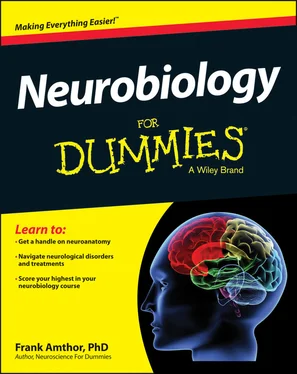1 ...7 8 9 11 12 13 ...23 Long before genes were known to be located on chromosomes composed of DNA, science had worked out some basic principles of inheritance, such as dominant and recessive traits. The upcoming sections explore these concepts in more detail.
Mendelian inheritance is one of the cornerstones of genetics, based on the famous pea experiments of the monk Gregor Mendel. Genes determine the features, or traits, that you inherited from your parents. Some traits you can see, such as height or hair color, and others you can’t, such as blood type. Genes are copied and inherited across generations. Different genes cause different traits to present themselves, and each unique form of a single gene is called an allele. So, for example, the gene specifying blue eyes comes from a different allele than the gene specifying brown eyes.
Organisms typically have two copies of each gene, one inherited from each parent. Each parent also has two copies of each gene, and passes along to its offspring a single copy by a (nearly) random selection of their two genes. This gene is found on a chromosome present in either the mother’s eggs or the father’s sperm. When the egg and sperm join, they form a double set of genes again.
The set of expressed traits of an organism are called its phenotype, whereas the genes within the organism are called its genotype. Since Mendel’s experiments, we have known that the traits an offspring expresses (phenotype) are not simply a mixing of the traits it got from the two sets of genes it inherited from its parents (genotype).
Determining dominant and recessive traits
One allele (that is, one particular form of a gene) may completely override the expression of another, making this the dominant allele. The non-expressed allele, or the allele that doesn’t show up in the offspring as a trait, is called the recessive allele. For a recessive allele to be expressed in an offspring as a trait, the offspring must receive two copies of the same recessive allele. Otherwise, the traits associated with the dominant allele will be expressed. For example, the O blood type is recessive compared to types A and B. An AO father and BO mother would have A and B blood types, respectively, because the alleles specifying A blood type and B blood type are dominant. However, because these parents both have the recessive O allele, they could potentially produce an OO child. ( This happens about 25 percent of the time.)
Most traits, such as height, depend on several genes. These traits have more complicated, mixed inheritance, because each of a number of genes contributes something to the end result. Mutations, which are random changes in genes, can also occur. Mutations can convert one allele into another, or even create a totally new allele and corresponding trait. (Go to the end of this chapter for more about mutations.)
 Mutations are fundamental to evolution because they allow species to change and adapt over time.
Mutations are fundamental to evolution because they allow species to change and adapt over time.
Greeting chromosomes and genes
Genes are made of DNA (DNA stands for deoxyribonucleic acid), a nucleic acid that is composed of long sequences of nucleotides. DNA exists in the form of a double helix that is tightly coiled within the nucleus of the cell.Only four types of nucleotides make DNA:
Adenine (A)
Cytosine (C)
Guanine (G)
Thymine (T)
Mitotic cell division or mitosis is the process in which chromosomes are duplicated, segregated, and allocated so that each daughter cell has a complete set of chromosomes derived from the parent. Eukaryotic organisms (those whose cells have a nucleus), such as animals and plants, have most of their DNA inside the cell nucleus — although some DNA exists in organelles such as mitochondria. Prokaryotic organisms (those whose cells generally do not have a nucleus), such as bacteria, have DNA in their cytoplasm.
Each organism has a unique sequence of DNA. The only exception: identical twins, although even identical twins may differ slightly because of mutations accrued during their development. Humans have 23 pairs of chromosomes that make up a total of over 3 million nucleotides.
 The total difference in the DNA sequence between two humans is less than 0.5 percent, whereas the difference between a human and a chimpanzee is about 2 percent.
The total difference in the DNA sequence between two humans is less than 0.5 percent, whereas the difference between a human and a chimpanzee is about 2 percent.
Replicating DNA and the cell life cycle
Cell division (see the preceding section) involves several additional processes.
DNA replication is the process of copying DNA. It’s important for cell division, so that each daughter cell inherits the full genome of its parent cell. The complementary double-stranded DNA molecule splits, and each strand produces a new complement, creating two identical copies of the double-stranded DNA sequence.
Cell division occurs in a cell cycle sequence (which we explore in a moment). A different type of DNA replication occurs in meiosis, producing daughter cells that have only half the number of chromosomes as the parent cell. A new chromosome can be created from a combination of both parent chromosomes in a process of breaking and joining, which is called crossover.
DNA replication begins when protein complexes sequentially unwind the DNA into two strands. As this unwinding proceeds, new strands that are complementary to each of the single strands are synthesized. The enzyme DNA polymerase is responsible for this process, because it adds nucleotides that are complementary to the nucleotides of the original strand.
The addition of nucleotides is based on the two pairs being complementary: Adenine binds to thymine, and cytosine binds to guanine via hydrogen bonds. One end is called the 3' (three-prime) and the other the 5' (five-prime) end. DNA polymerase (see the upcoming section, “ Coding for proteins: RNA and DNA”) synthesizes DNA directionally by adding the 5' end of a nucleotide to the free 3' end of a nascent DNA strand. Thus, the DNA strand is elongated in the 5' to 3' direction.
The cell cycle is the process by which one parent cell divides into two daughter cells. This cycle involves both DNA replication and cell division. In eukaryotes, the phase when the cell is not dividing is called interphase. The division of the cell into two daughter cells occurs during mitosis, which is itself divided into different phases: prophase, metaphase, anaphase, and telophase. After telophase, cytokinesis occurs, which is the phase when the cytoplasm actually divides into two daughter cells.
Coding for proteins: RNA and DNA
Protein synthesis is the process by which cells generate proteins from the code in the DNA sequence. It occurs in several stages, including transcription from DNA to messenger RNA (mRNA), and translation, or the assembly of proteins by ribosomes using the mRNA template. (RNA is a nucleotide like DNA, except is has the nucleotide uracil substituted for thymine.) This section explores these stages.
 The DNA molecule is a double-stranded helix. It’s well suited for storing and replicating biological information because the two strands are complementary. An adenine in one strand is always bound to a thymine in the other, and likewise for guanine and cytosine, called base pairing. This complementary structure enables replication by splitting the two DNA strands, so each forms a new complement strand. The double helix is stable and resistant to cleavage, allowing the body’s trillions of cells to store the genetic code.
The DNA molecule is a double-stranded helix. It’s well suited for storing and replicating biological information because the two strands are complementary. An adenine in one strand is always bound to a thymine in the other, and likewise for guanine and cytosine, called base pairing. This complementary structure enables replication by splitting the two DNA strands, so each forms a new complement strand. The double helix is stable and resistant to cleavage, allowing the body’s trillions of cells to store the genetic code.
Читать дальше

 Mutations are fundamental to evolution because they allow species to change and adapt over time.
Mutations are fundamental to evolution because they allow species to change and adapt over time. The DNA molecule is a double-stranded helix. It’s well suited for storing and replicating biological information because the two strands are complementary. An adenine in one strand is always bound to a thymine in the other, and likewise for guanine and cytosine, called base pairing. This complementary structure enables replication by splitting the two DNA strands, so each forms a new complement strand. The double helix is stable and resistant to cleavage, allowing the body’s trillions of cells to store the genetic code.
The DNA molecule is a double-stranded helix. It’s well suited for storing and replicating biological information because the two strands are complementary. An adenine in one strand is always bound to a thymine in the other, and likewise for guanine and cytosine, called base pairing. This complementary structure enables replication by splitting the two DNA strands, so each forms a new complement strand. The double helix is stable and resistant to cleavage, allowing the body’s trillions of cells to store the genetic code.










